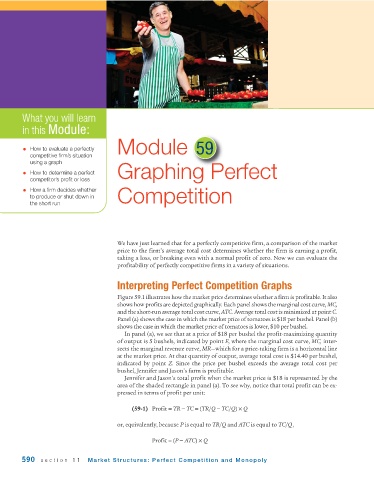Page 632 - Krugmans Economics for AP Text Book_Neat
P. 632
What you will learn
in this Module:
• How to evaluate a perfectly Module 59
competitive firm’s situation
using a graph
• How to determine a perfect Graphing Perfect
competitor’s profit or loss
• How a firm decides whether
to produce or shut down in Competition
the short run
[CO-BL-F]
We have just learned that for a perfectly competitive firm, a comparison of the market
price to the firm’s average total cost determines whether the firm is earning a profit,
taking a loss, or breaking even with a normal profit of zero. Now we can evaluate the
profitability of perfectly competitive firms in a variety of situations.
Interpreting Perfect Competition Graphs
Figure 59.1 illustrates how the market price determines whether a firm is profitable. It also
shows how profits are depicted graphically. Each panel shows the marginal cost curve, MC,
and the short-run average total cost curve, ATC. Average total cost is minimized at point C.
Panel (a) shows the case in which the market price of tomatoes is $18 per bushel. Panel (b)
shows the case in which the market price of tomatoes is lower, $10 per bushel.
In panel (a), we see that at a price of $18 per bushel the profit-maximizing quantity
of output is 5 bushels, indicated by point E, where the marginal cost curve, MC, inter-
sects the marginal revenue curve, MR—which for a price-taking firm is a horizontal line
at the market price. At that quantity of output, average total cost is $14.40 per bushel,
indicated by point Z. Since the price per bushel exceeds the average total cost per
bushel, Jennifer and Jason’s farm is profitable.
Jennifer and Jason’s total profit when the market price is $18 is represented by the
area of the shaded rectangle in panel (a). To see why, notice that total profit can be ex-
pressed in terms of profit per unit:
(59-1) Profit = TR − TC = (TR/Q − TC/Q) × Q
or, equivalently, because P is equal to TR/Q and ATC is equal to TC/Q,
Profit = (P − ATC) × Q
590 section 11 Market Structures: Perfect Competition and Monopoly

